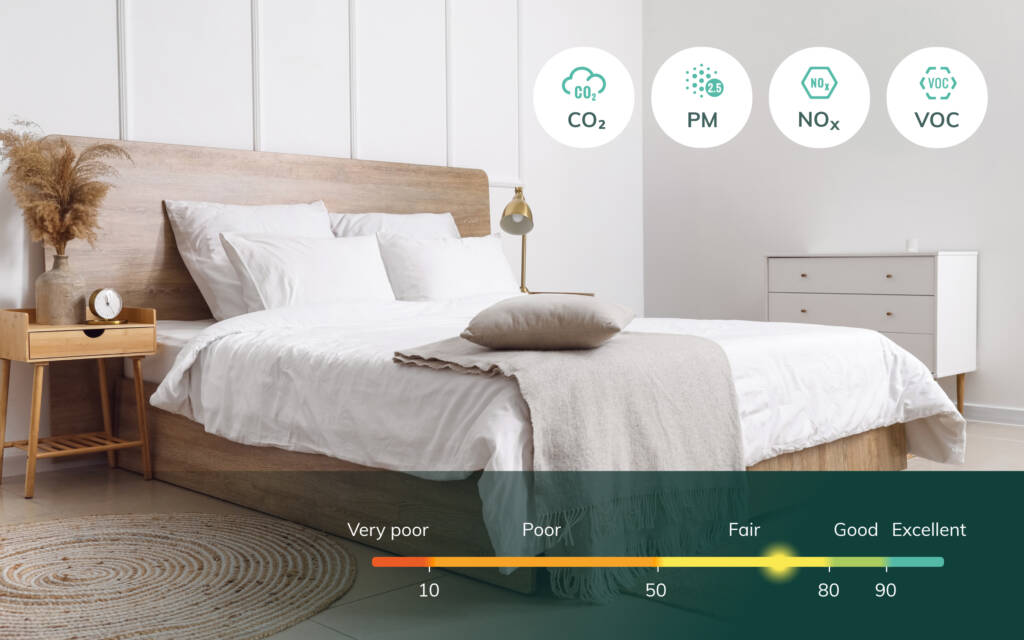
Measuring carbon dioxide (CO₂) levels in your bedroom could hold the key to more restful sleep. Research shows that elevated CO₂ levels at night can disrupt your natural sleep cycles, increase wakefulness, and reduce how refreshed you feel in the morning.
Why Carbon Dioxide Builds Up in Bedrooms at Night
When we sleep in closed rooms with doors and windows shut, CO₂ levels can quickly rise, especially with two or more people sharing the same space. Breathing naturally produces CO₂, and without adequate ventilation, concentrations can easily surpass 1,000 ppm (parts per million), sometimes climbing to 2,000–3,000 ppm by early morning. The World Health Organization recommends keeping indoor CO₂ below 1,000 ppm to maintain healthy air quality.
The link between CO₂ and sleep quality
Several studies show that even moderate increases in CO₂ can impair how well we sleep:
- At 1,900–3,000 ppm, sleep quality drops significantly, with longer time to fall asleep and less deep, restorative sleep.
- A 2024 Building and Environment study found that high CO₂ reduced sleep quality more than changes in temperature or humidity.
- Bedrooms with over 900 ppm CO₂ consistently show reduced next-day alertness and cognitive performance.
High CO₂ affects the autonomic nervous system by triggering lighter sleep stages and increased breathing effort, leading to a faster heart rate and fewer slow-wave sleep phases critical for recovery.
How CO₂ affects your body overnight
When carbon dioxide concentrations increase:
- Your body responds by breathing faster to balance blood oxygen and carbon dioxide.
- Heart rate rises instead of lowering during deep sleep.
- The body enters a mild stress state, making restful sleep harder to achieve.
This can result in morning headaches, grogginess, and slower reaction times, symptoms often misattributed to poor sleep schedules rather than indoor air.
Measuring CO₂ in the Bedroom
Ideal CO₂ levels for sleep
Healthy indoor CO₂ levels should ideally stay below 1,000 ppm, with readings under 800 ppm considered excellent for bedrooms. Fresh outdoor air is typically around 420-430 ppm.
Continuous monitoring helps you see patterns: levels tend to spike between 2–4 a.m. and drop again once the room is ventilated. Tracking these fluctuations gives useful insight into how your room’s air changes overnight.

Tools for smarter monitoring
Ruuvi Air is designed for continuous and precise CO₂ measurement. It tracks multiple parameters: carbon dioxide, particulate matter, VOCs, NOx, temperature, humidity, and air pressure, and calculates an easy-to-read Ruuvi Indoor Air Quality Score (IAQS) that combines CO₂ and PM2.5 levels.
Data can be viewed in real-time using the Ruuvi app or remotely through the Ruuvi Gateway. When CO₂ levels rise, you’ll get alerts to ventilate, helping you maintain optimal air and healthier sleep.
Improving Air Quality for Better Sleep
Practical steps for fresher nights
- Ventilate regularly: Open the window or door before bedtime; even a small airflow can halve overnight CO₂ levels.
- Use smart monitoring: A device like Ruuvi Air gives insight into when ventilation or air purification is needed.
- Optimize temperature & humidity: Keep temperature between 18–22 °C and humidity between 35–50 % for comfort and respiratory health.
- Avoid overcrowding: More people or pets increase CO₂ faster.
- Add plants strategically: While plants add oxygen, they have a modest effect. Focus on mechanical ventilation for real results.
Why Measuring Indoor Air Quality Matters
Good indoor air is invisible but life-changing. Continuous CO₂ monitoring not only leads to better sleep but also supports focus, energy, and long-term health. Understanding what you breathe at night lets you take small, data-based steps toward major daily improvements.
By measuring and adjusting your bedroom air quality, you’re investing in one of the simplest, most natural ways to improve your recovery and well-being. Every single night.
FAQ: How Carbon Dioxide Affects Your Sleep
Why does carbon dioxide build up in bedrooms at night?
CO₂ builds up because we exhale it while breathing, and in closed rooms with little ventilation, it accumulates. This is especially true for bedrooms with two or more people and closed windows or doors, where CO₂ levels can easily exceed recommended safe limits.
What CO₂ level is safe for good sleep?
Indoor CO₂ levels should ideally stay below 1,000 ppm (parts per million), with levels under 800 ppm considered excellent for bedrooms. Outdoor air typically has CO₂ levels around 420–430 ppm.
How does elevated CO₂ affect sleep quality?
Elevated CO₂, around 1,900 to 3,000 ppm, can reduce sleep quality by increasing the time it takes to fall asleep, causing lighter, less restorative sleep. It can also trigger faster breathing, a higher heart rate, and less slow-wave deep sleep, all important for recovery. This often leads to morning grogginess and slower cognitive performance.
Why am I tired despite getting enough sleep?
High CO₂ levels disrupt natural sleep cycles even if you spend enough time in bed. The body reacts to CO₂ buildup by entering a mild stress state during sleep, resulting in poorer rest and symptoms like headaches and sluggishness in the morning
How can I measure CO₂ in my bedroom?
Devices like Ruuvi Air provide continuous and precise measurement of CO₂ along with other air quality factors such as particulate matter, VOCs, and humidity. It tracks data in real-time via an app and provides alerts when ventilation is needed to maintain healthy air quality.
What practical steps improve bedroom air quality for better sleep?
- Ventilate regularly: Opening a window or door before bedtime can halve CO₂ levels overnight.
- Use smart monitoring to know when to ventilate or purify air.
- Keep temperature between 20–25 °C and humidity between 35–50% for optimal comfort.
- Avoid overcrowding the room, as more occupants increase CO₂ faster.
- Adding plants has a modest effect; focus on mechanical ventilation for real results.
Why is monitoring indoor air quality important?
Good indoor air quality impacts not only sleep but also daytime focus, energy, and long-term health. Measuring and managing the air you breathe nightly is a simple, effective way to improve overall well-being and recovery.